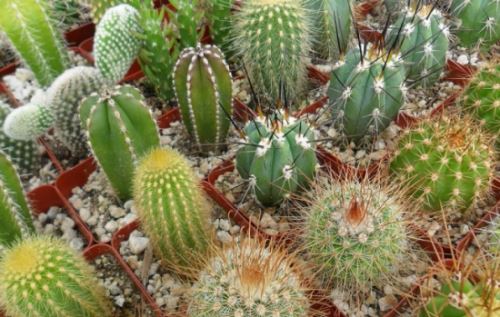Cactus: home care - all the secrets!
Read about caring for a cactus at home: lighting, temperature, soil. We consider in detail how to properly water a cactus in spring, summer, autumn and winter (frequency, methods, water for irrigation).
We also describe what fertilizer is needed for cacti, how to transplant, propagate and grow from seeds at home.
Lighting and temperature for a cactus at home
Caring for a cactus at home is quite simple, as the plants themselves are hardy and unpretentious, but we still need knowledge, skills and care.
Lighting and temperature
Light for cacti is very important for development and growth. They love a lot of sunlight (light-loving), so it is better to place them on the south window, if there is none, then on the west or east.
If the cactus grows on the north side, then it must be additionally illuminated. An insufficient amount of light is manifested in the thinning of the top.
- Shade-loving plant species do not exist, there are only some shade-tolerant ones.
Summer
The bright rays of the sun in summer rarely harm the flower; only forest species (ripsalis, etc.) recommend shading.
It is useful to ventilate cacti and expose them to fresh air (balcony, veranda), but at the same time protect them from dust, rain and wind. In rainy weather, cover them with foil.
Gradually increasing the airing time, the plants adapt to the street and after 2-3 weeks they can be kept outdoors around the clock, until the end of summer.
Nighttime temperature changes strengthen the skin of the cactus, endow them with shiny spines, allow them to overwinter more easily, increase resistance to disease and improve flowering. Drafts are the main danger.
Winter
In winter, cacti can hardly tolerate dry air with high temperatures. Place the flower on the windowsill further from the battery and closer to the glass (without touching!).
- The optimum temperature for cacti will be 16-24 ° C. It is better for cacti to winter at 10-15 ° C and without drafts. Epiphytic species need a warmer place.
Most species of such genera are more likely to bloom during a warm winter: aporocactus (Aporocactus), hymnocalycium (Gymnocalycium), melocactus (Melocactus), notocactus (Notocactus), parody (Parodia) and ripsalis (Rhipsalis).
The rest of the species need a cold wintering (8-13 ° C) for flowering. In room conditions, it is difficult to achieve such a temperature, because heating radiators are located next to the windowsill.
Therefore, flower growers either take the plants to a cool balcony, loggia, or protect them from a heat source with the help of partitions made of thick cardboard, polystyrene and other improvised materials.
IMPORTANT: The cactus does not like frequent rearrangements. Do not turn it with the other side to the light (put a mark on the pot so as not to be mistaken), for a more even growth - it is absolutely impossible to do this during budding and the beginning of flowering!
Such a lonely and such a beautiful cactus ...
How to water a cactus at home?
Many flower growers think about how to water a cactus at home and do it right, because watering plays a very important role in the life of a plant.
How often should a cactus be watered? (winter spring Summer Autumn)
Winter
From November to early March, cacti have a dormant period. At this time, the need for moisture is minimal. In order for the cactus to bloom, you need a low temperature and poor watering.
Large and old specimens are watered every 4 weeks, and small ones more often - once every 14-20 days with a small amount of water (literally one or two tablespoons). You can spray cacti with warm water once a month - before budding and flowering, and water once a month.
During the period of budding and the beginning of flowering, epiphytic cacti and prickly pear can be watered, while cereus cacti are only sprayed with warm water. Waterlogging leads to the fact that “babies” grow out of buds instead of flowers.
- Many flower growers recommend not watering cacti at all in winter and get excellent results of flowering and further development.
The editors of the magazine "Feast of Flowers" recalls that you need to remember the specific features. If in doubt, then water the cacti in the winter in a gentle mode, which is described above.
Spring
As the temperature rises and the amount of light increases, the cacti "come to life" and the need for water gradually increases.
Spray about once every 14-20 days. The dates are approximate for central Russia, the principle is the same: the warmer and lighter, the more often.
Summer
In summer, cacti are watered most often, as there is maximum growth and intensive development of the plant.
How often should a cactus be watered in summer?
Autumn
In autumn, the cactus is gradually prepared for a dormant period and subsequent flowering. They are watered less and less along with a decrease in temperature: September - once every 5-7 days, October - once every 10-14 days.
From November to March (rest period) every 25-30 days in a small amount.
General rule: It is better to water cacti less often and less than more often and more.
Top dressing and fertilizers
The use of fertilizers for cacti is covered in different ways in the literature and is accompanied by long disputes. We can say for sure that cacti need a small amount of nitrogen and its excess leads to improper plant development.
Cacti need calcium and phosphorus, and during the flowering period - potassium. Therefore, it is better to use a special fertilizer for cacti and succulents.
Quite popular fertilizer "Cactus" with a balanced composition of micro and macro elements. Release form - 0.5 l bottle.
Universal feeding period: from April to early September once every two weeks.
ATTENTION!
- The period of growth and flowering in cacti often do not coincide, so do not top dress in the winter when the plant blooms. For such species, you can slightly increase watering.
- Do not apply fertilizer for cacti after transplanting and before it.
REFRESH YOUR KNOWLEDGE:

Various types of cacti
Cactus transplant at home + soil
It is best to transplant the cactus from the end of March to the end of May. Young plants are transplanted every year, and adults (from 4 years old) every 2-3 years before the start of active vegetation (March).
Transplant plan
- Do not water the flower 3-4 days before transplanting for the convenience of separating the soil from the roots.
- At the bottom of the pot, be sure to use a drainage layer (2-4 cm) - stagnant water is contraindicated for cacti (especially for epiphytes). Fill the holes with shards, pour fine gravel, expanded clay, charcoal or coarse sand on top.
- Depending on the depth of the pot and the length of the roots, a 2-4 cm layer of soil mixture is poured on top of the drainage. The plant is placed on the ground and the roots are straightened, while the base of the cactus should be on the line of the edge of the pot.
- After that, they begin to fall asleep around the substrate to the root neck, periodically shaking the pot and compacting the soil. On top of the substrate, you can pour a 1 cm layer of sand.
- The first 3-4 days after transplanting the cactus, do not water it and do not put it in direct sunlight.
Which cactus pot to choose?
The main thing is that the volume of the cactus pot should not be much larger than the volume in the straightened form of the root system and take into account the characteristics of the species.
Example: Ariocarpus is suitable for a deeper than a wide pot, and mammillaria have many children and many plants grow in one dish over time.
For instances with short and branched roots, a low and wide pot is selected, a deeper and narrower one is suitable for a cactus with long roots or a rod type.
Form. Between the square and round shape of the container, it is better to choose the second option. However, if you have a large number of cacti or you are constantly expanding your collection, then square or rectangular pots save space on the windowsill and are easier to carry on a tray to another place.
Material. Suitable for both plastic and clay. Cacti are not picky about the material, they do not recommend using only a metal container.
soil mix
The soil for cacti differs depending on its type, age, etc. Experienced flower growers can find various examples of the substrate.
General features are as follows: the soil for a cactus should be loose, slightly acidic (pH = 4.5 - 6), light and nutritious (the ratio of minerals varies).
A standard do-it-yourself potting mix would be: leaf earth and river sand (1:1) + some peat (to increase acidity) and powder with small pieces of hardwood charcoal.
Young plants and seedlings need a looser and more nutritious soil mixture (increase some of the leafy soil). A denser substrate is suitable for adult plants; for this, clay-turf soil is added to it.
- Tricks: for rapidly growing species, it is useful to add humus to the substrate. For cacti with a lot of spines, it is useful to add crushed eggshells to the mixture.
HELPFUL INFORMATION:
Pests and diseases
An excess of moisture, especially in winter, leads to the formation of rot. When the roots rot, the cactus is taken out of the pot, the roots are washed with running water, and dried.
Then rotten leaves and stems, soft and dark roots are cut off, and also treated with an antiseptic (only roots). Plant the cactus in a new pot and do not water until it begins to grow.
Of the pests, the cactus is affected by: spider mites, aphids, scale insects and mealybugs.
- The main thing is to inspect the plant weekly through a magnifying glass and avoid excessively dry air. Remember that regular inspection is much easier and more enjoyable than pest control or disease treatment.
FLOWER'S REMINDER:
If you have questions about how to care for a cactus at home, you can ask them in the comments.




